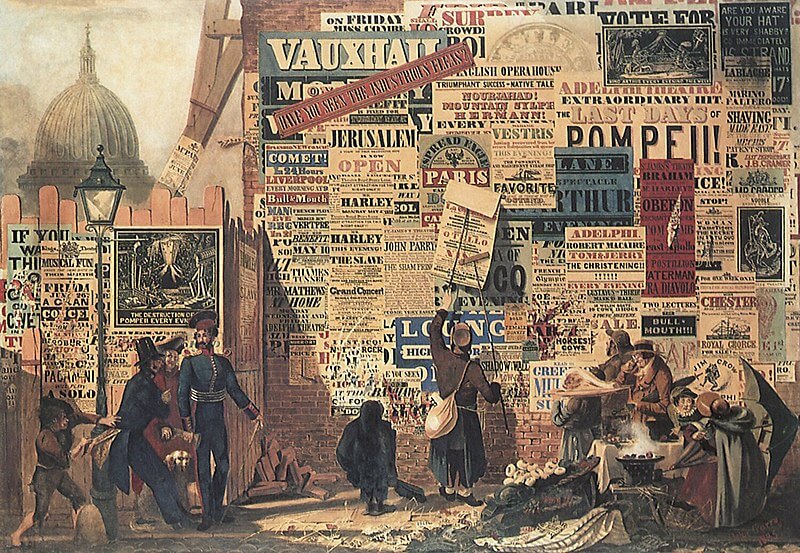Marketers have bombarded potential buyers with messaging for a very long time.
What’s changed in recent times is that buyers have more access to the trusted voice of their peers. In B2B SaaS, the rise of content marketing in the 2010s has evolved from vendor-led eBooks and whitepapers to today’s peer-led content, from communities like Pavilion and Demand Curve to guest-driven podcasts like The Official Saastr Podcast and the Testimonial Hero podcast.
Increasingly, peer voice is cutting through the noise of vendor messaging.
In the words of Testimonial Hero, “It’s easy to dismiss the assurance of the business trying to sell you a product or service…It’s difficult to overlook the word of an established peer who is providing actual results and concrete numbers to prove a company’s effectiveness.”
eMarketer found that consumer (similar to peer) reviews are more trusted (nearly 12 times more) than vendor descriptions.
Savvy Marketers and companies have caught on and are leveraging the voice of the customer in their messaging. They use it in multiple forms, primarily testimonials, case studies, and reviews. In doing so, these Marketers are persuading their buyers with social proof.
But what is social proof? Why does it work? And how do you use reviews, case studies, and video testimonials as social proof?
Let’s dive in.
What is social proof, and how do testimonials, case studies, and reviews create it?
Have you ever been unsure of what to do in a particular situation, so you copied what someone else was doing whom you thought knew better? If you have (and whether you like it or not, you have), you were persuaded by social proof.
Companies leverage this phenomenon to persuade more of the unsure by pointing them to the behaviour of others they may perceive to know more about the company’s product or service.
“The internet has digitized word-of-mouth reviews and recommendations, making it much easier for people to rely on social proof as a shortcut for decision-making (emphasis added),” said Think With Google. We longer need to rely on our real-life networks. We can also just search online when needed and find the opinion of our peers and others like them.
There are six types of social proof, according to Buffer:
- User
- Celebrity
- Expert
- The wisdom of the crowd
- The wisdom of your friends
- Certification
In this post, we’re focusing on user-generated social proof as it’s one of the most used, if not the most used, types of social proof in B2B SaaS.
The three main types of social proof featuring user/customer stories are:
- Testimonials
- Reviews
- Case studies
Gartner defines the three as follows:
- Customer quotes. Customers may share their experience with your product or service through a reference statement or testimonial (emphasis added). This statement can be shared on social media, your website, or pitch decks.
- Customer references. Also called case studies (emphasis added), references are similar to quotes in that they share a customer success story, but in more detail. A collection of case studies can be used by your sales team to complement a pitch deck.
- Reviews. Reviews are customer feedback on a specific product or service you offer. They may include details about your business’s customer service experience, and can be promoted online.
Why use all three?
According to Gartner research, “more than 75% of B2B buyers consult three or more sources of advocacy before they make a purchase decision (full research available to Gartner clients only).” Therefore, B2B buyers are going to their colleagues, peers, vendors, and other organizations to find different advocate voices. You can present advocate voices in multiple forms by leveraging testimonials, case studies, and reviews.
Another proof point for social proof: Demand Curve has helped over 1,000 startups and found that effectively using social proof can lead to up to 400% improvement in conversion.
For a practical example, PartnerStack saw a growth inflection point when it started building up a Marketing function focusing on reviews, case studies, and video testimonials to leverage the power of social proof.
Once you understand what social proof is and why it’s essential, the next question to answer is where to use it in your Marketing and Sales.
Where to use testimonials, reviews, and case studies in the buyer’s journey?
The simple answer is to use all of them throughout (the buyer’s journey).
However, I believe it’s worth going one level deeper to understand better how to best match how you present your customer voice to where the buyer may be in the buying journey.
Unfortunately (for B2B Marketers and Sellers), it isn’t as simple as using testimonials at the top of the funnel, case studies at the middle of the funnel, and reviews at the bottom of the funnel. While that may be the oversimplified place to put each form of social proof in your funnel, buyers have a mind of their own.
Today’s B2B buyers tend to chart their course in their buying journey, and the journey looks more like a series of loops than a funnel or a direct path. Before making a purchase, a buyer could see a review, testimonial, or case study at the start or middle of their buying journey and loop back to it before the end (purchase decision).
To the extent that you can control the buyer’s journey, or at least what outbound messaging you provide to them in ads and sales outreach, there are, arguably, better times to use each type of user social proof.
When your buyer is near the start of their buyer journey, a testimonial may be your best bet to get their attention and interest. It quickly highlights one of the main benefits you provide to your customers in a real example, whether in an ad headline or a 90-second video testimonial.
A review (or a case study) may provide overwhelming detail that a prospect may dismiss until they know why it’s worth their time.
Work with Sales teams that do outbound prospecting. You’ll know how keen they are to have as many short customer stories as possible to tailor to the prospect based on their firmographics (company size, industry, etc.) and demographics (role, seniority, etc.). While a detailed case study may be ideal for later in a Sales cycle, testimonials or review snippets – i.e. messages that your audience can consume in seconds, not minutes – tend to win the day.
But who said you have to separate testimonials from reviews and case studies? Combining them helps vendors leverage their customer voice for optimal effect.
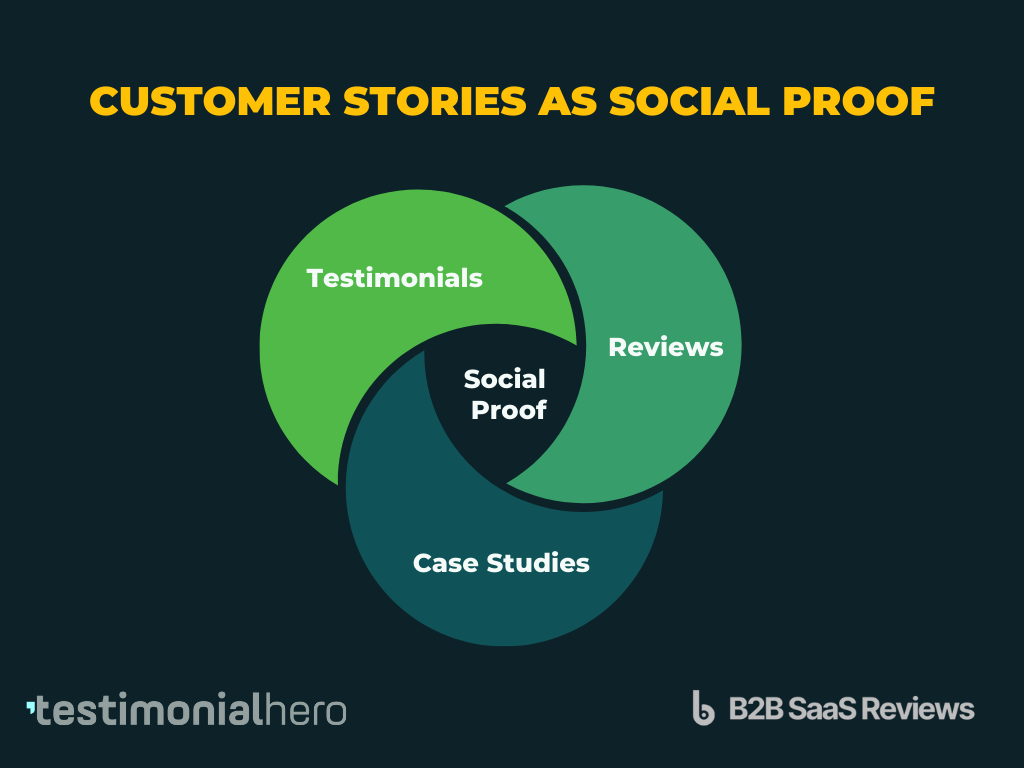
To the vendor (Acme Corp, for example), combining reviews, testimonials, and case studies could look something like this:
- Review request trigger: e.g. onboarding complete, NPS response, user milestone achieved, etc.
- Customer writes a review on Acme Corp on a third-party review site.
- A new advocate was identified (the review is positive).
- Send a testimonial video request.
- Turn the testimonial video into a detailed case study.
- Use snippets from review and testimonial video leveraged in ads, landing pages, emails, webpages, social media (posts), and sales material/enablement.
To the buyer, it could look something like this:
- Hears from a peer about software that’s helping them.
- Sees other peers talking about the same software category in a peer community.
- Searches Google for more info on the software category.
- Clicks on a link to a business software review site with the vendors in that category to check out the top three rated vendors.
- Sees a sponsored video testimonial from one of these vendors with a customer success story days later.
- Receives an email shortly after that from a BDR with a review snippet of another happy customer that’s like them.
- Visits the vendor website and watches a couple more customer testimonial videos before deciding whether to respond to the BDR
- Responds to the BDR to set up a Sales call.
- Listens to a Sales rep tell them more success stories of customers similar to them.
- Receives a detailed case study from the Sales rep to review post-call.
- Goes dark for six months as other things take priority.
- Hears from a peer that they’ve got the software they (the buyer) were looking into and that they (the peer) love it.
- Returns to the business software review site to read more thoroughly through several reviews of the top three products on their shortlist.
- Reaches out to a couple of the customers who wrote a review and were featured in the video testimonial for a reference call.
- Searches Google for the vendor site and submits a request to talk to Sales.
- They go through another Sales cycle and buy the software they believe has best-helped peers like them.
The point is that testimonials, case studies, and reviews can play an important role in the many touchpoints on a long and looping B2B SaaS buying journey.
That means vendors need to find effective ways to generate testimonials and reviews.
How to get testimonials and reviews
There are as many review generation tactics in B2B software as there are ways how to ask for B2B customer testimonials.
How can you get testimonials and reviews?
The approach will depend on asking first for the review or the testimonial.
Suppose you’ve asked first for the testimonial (and received it). In that case, one way to make it easier for your customer to write you a review is to take the best part(s) of the video testimonial transcript and present them with it (in text form), saying something like:
Hey [Customer Name}, I loved when you made {these points} in the video testimonial. I clipped them out here in transcript form. Would you mind also posting this on {business software review site (G2, Capterra, Et Al.)?
By providing these excerpts to the customer, you’re not only subtly showing them that they have already put into words much of their review of your product. You’re also reducing the time a review would take them by providing the more time-consuming written answer components, and it’s still in their own words—win-win.
If you’ve asked for the review first (and received it), filter your reviews by rating and go through the 4 and 5-star reviews as video testimonial candidates. Suppose you’re fortunate enough to have many glowing reviews from which to choose. In that case, you could also layer on the customer’s role, industry, company, and other things that would help you prioritize which customers you believe would serve you best in a video testimonial.
So whether you start with a video testimonial or a review on a third-party site, both paths will help you achieve social proof.
How to use testimonials, case studies, and reviews as one customer success story
Reviews, case studies, and testimonials go hand-in-hand.
Testimonial Hero says, “Customer reviews can be your most valuable asset, but only if you leverage them correctly.”
Testimonial Hero argues that the best way to leverage reviews is to turn the best ones into video testimonials. “Getting the most out of testimonials means choosing positive reviews that are relevant to your incoming sales prospects. Then placing them strategically throughout your sales funnel.”
For example, on Testimonial Hero’s work page, i.e. the page that showcases some of the video testimonials that it has made for its customers, there are both video testimonials and G2 reviews to complement one another.
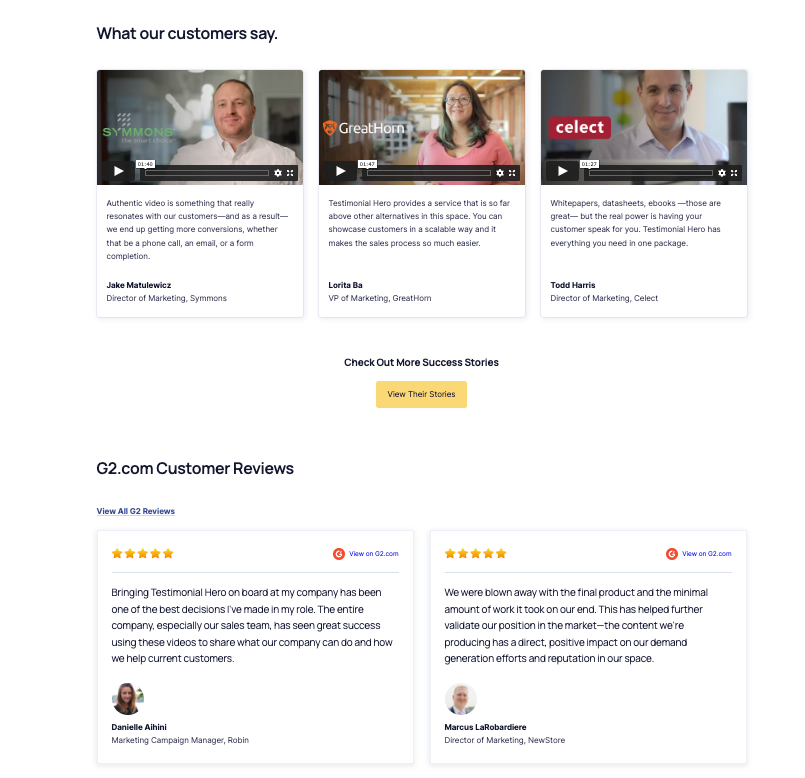
As you can see on this page, especially if you visit the page and engage with the content, a video testimonial brings a vendor’s best reviews to life.
As Testimonial Hero says, “By filming someone, you can pick up on their authentic reaction to the product and learn from their enthusiasm and nonverbal expressions. You can assess the person who is using the product and decide if they are credible or not.”
We (PartnerStack) decided to work with TestimonialHero to create video testimonials to bring our best reviews and reviewers to life. When we approached TestimonialHero in early 2021, we built up our customer reviews to the point where we could select some of our best customers’ reviews and bring them to life by featuring the customers on film.
Today, PartnerStack features these video testimonials proudly on our customer stories page.

Alongside these video testimonials are long-form written case studies. By having both formats (short video testimonials and long written case studies), we believe that we’re providing our buyers with options so that they can choose the format that best fits their current needs.
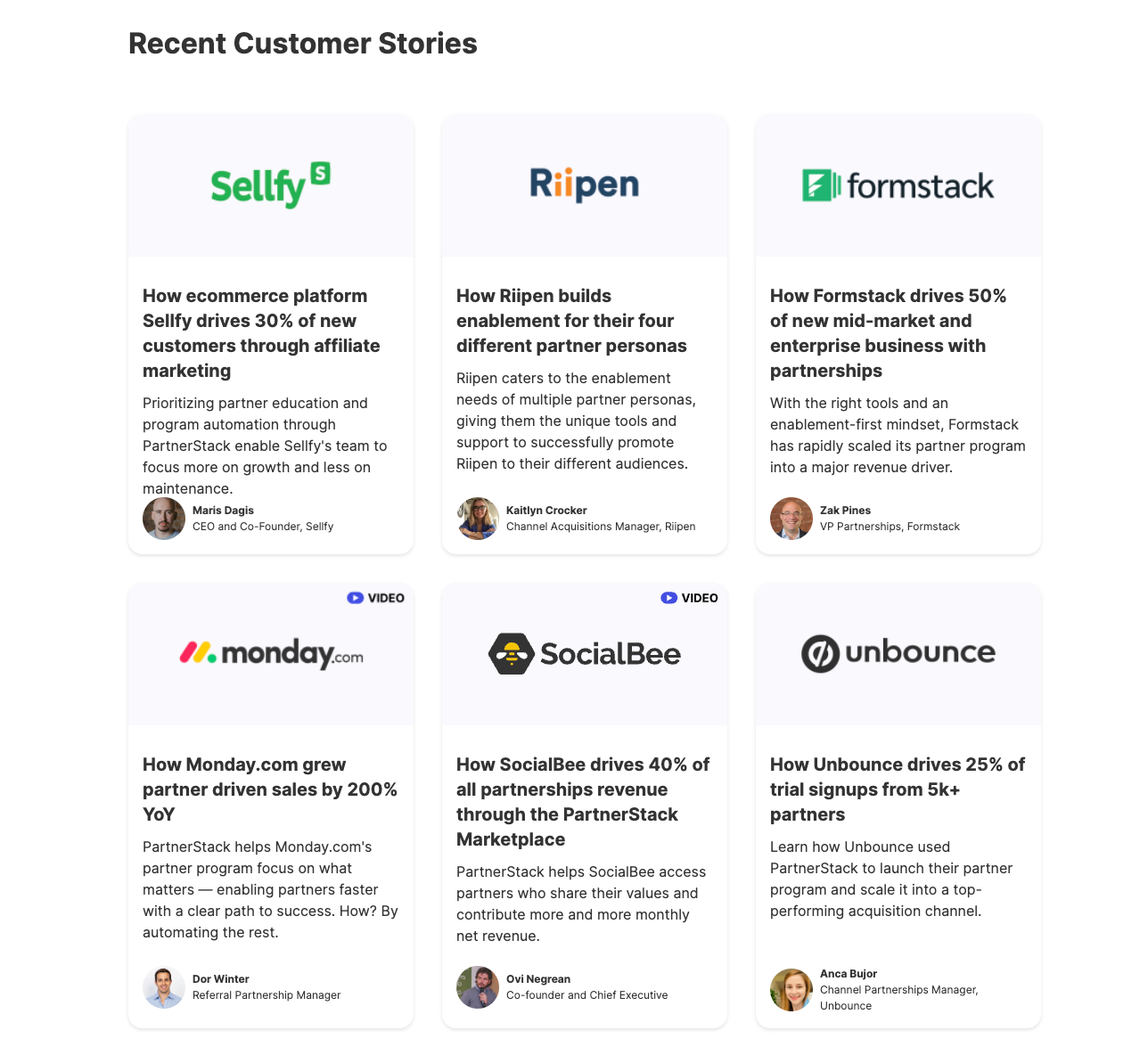
While we don’t have reviews on our customer stories page, we leverage reviews in so many ways that our buyer is likely exposed to them more than once throughout their buying journey.
We probably should add reviews to our customer stories page because video testimonials only showcase customer success stories. Buyers tend to be suspicious if they are only presented with positive social proof.
To overcome social proof skepticism, vendors can balance their glowing customer success stories told in video testimonials with positive and negative reviews. Including the less glowing customer voice provides the buyer with a sense of credibility in the information source to trust it.
A written review on a business software review site provides added credibility by adding to the “wisdom of the crowd.” Because review sites aggregate ratings in each product profile, and written reviews span the star rating spectrum, from negative to positive reviews, written reviews provide a broad range of user experiences with the product.
Testimonials can better capture attention and interest and communicate the main benefits and results in less time than reviews, making testimonials stronger top-of-funnel content.
Reviews better capture the user’s experience with the solution and expand on how they use the solution to achieve the benefits they do and the challenges and limitations that they’ve faced with it, making reviews arguably stronger middle-and-bottom of the funnel content.
TrustRadius Founder, Vinay Bhagat, made a case for reviews on Content Marketing Institute back in 2014:
I’ll share an example of a vendor-produced case study and contrast it with in-depth end-user reviews of the same product, (Marketo) by the same company (Navicure). The case study focuses on benefits, whereas the review gives a detailed perspective of what it’s really like to use the product.
While it’s safe to say that reviews haven’t replaced case studies, a look at the history of online reviews shows the rise of reviews (for B2C in the 2000s and B2B in the 2010s), leading to both case studies and reviews (and testimonials) to have their place in the buyer journey.
Coming full circle, “getting the most out of testimonials means choosing positive reviews that are relevant to your incoming sales prospects. Then placing them strategically throughout your sales funnel.”
It would be best if you had reviews, testimonials and case studies. But they’re only effective when your target audience sees them.
How to leverage social proof in your Marketing
Once you have reviews and testimonials, then you need to use them as social proof in your messaging on:
- Ads
- Landing pages
- Emails
- Website (homepage and customer page)
- Social media (posts)
- Sales material / enablement
Your customer stories can take shape in all of these forms.
Here is an example of how we at PartnerStack helped tell the success story of Gorgias’s partner program.
September 2020 – Review: PartnerStack invites Gorgias’s VP of Business Development & Partnerships, Philippe Roireau, to write a review on G2; Philippe writes the review.

July 2021 – Video Testimonial: PartnerStack asks Philippe to provide a video testimonial for PartnerStack; Philippe agrees, and Testimonial Hero helps make the testimonial video.

August 2021 – Landing Pages: PartnerStack Marketing team adds Philippe’s video testimonial to select pages to add social proof.

September 2021 – LinkedIn Sponsored Update video ad: Philippe is featured in a PartnerStack video ad, leveraging a 30-second excerpt from his video testimonial.
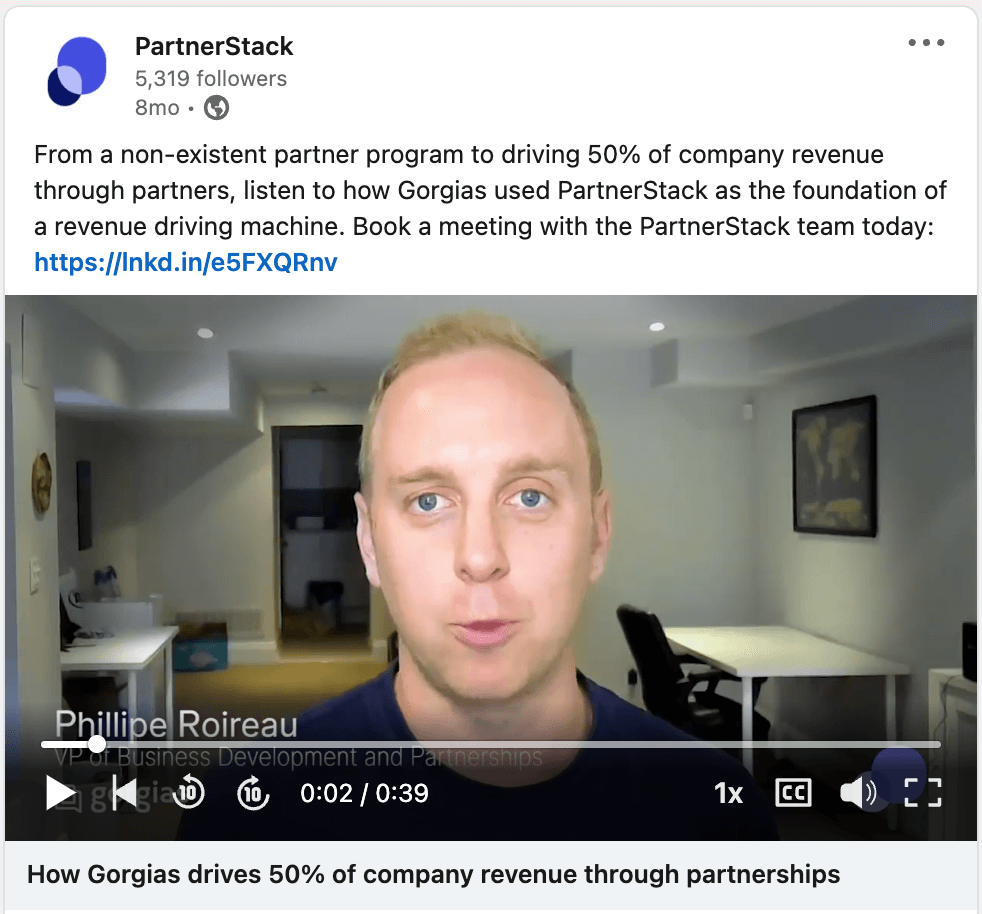
September 2021 – Sales material/enablement, social media, and website: The PartnerStack Marketing team internally shares with the Sales team Philippe’s video testimonial, where to find it on our website and social channels, and how to use it. The PartnerStack Sales team starts to share the Gorgias partner success story.
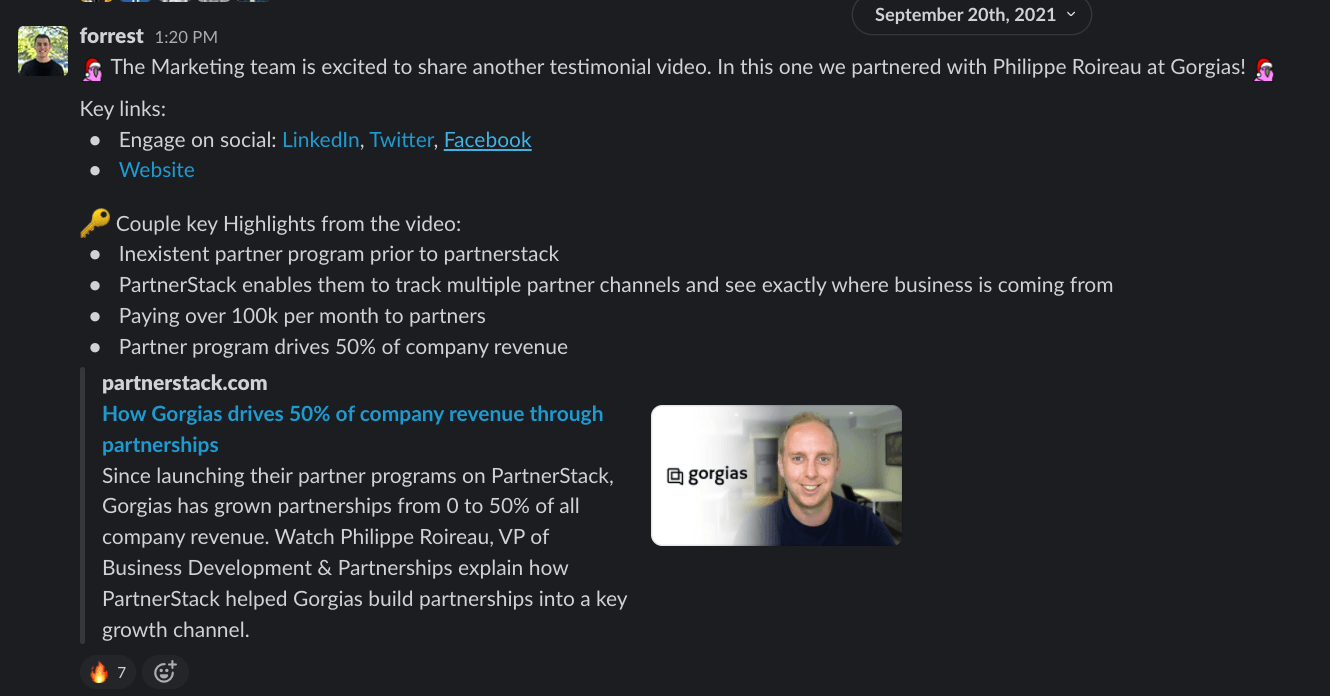

September 2021 – Customer Reference Panel: PartnerStack asks Philippe to participate in a customer reference panel; Philippe agrees to join the panel.

November 2021 – Sales material/enablement: Philippe is featured in a two-minute “sizzle reel,” edited by Testimonial Hero from our five video testimonials. Our Growth Marketer shares the video internally with our Sales team.
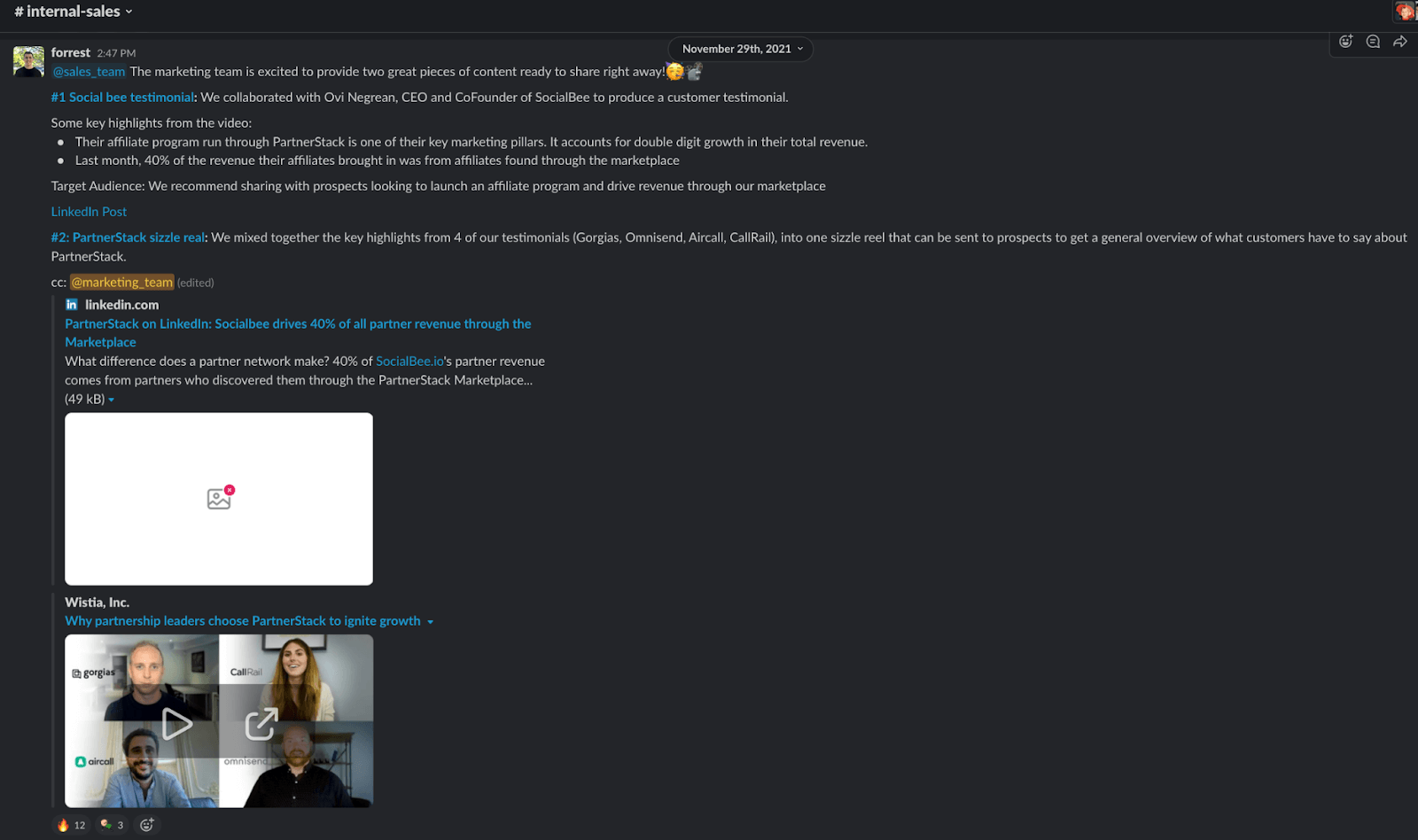
December 2021 – LinkedIn Sponsored Update video ad: Philippe is featured in a two-minute “sizzle reel,” edited by Testimonial Hero from our five video testimonials.
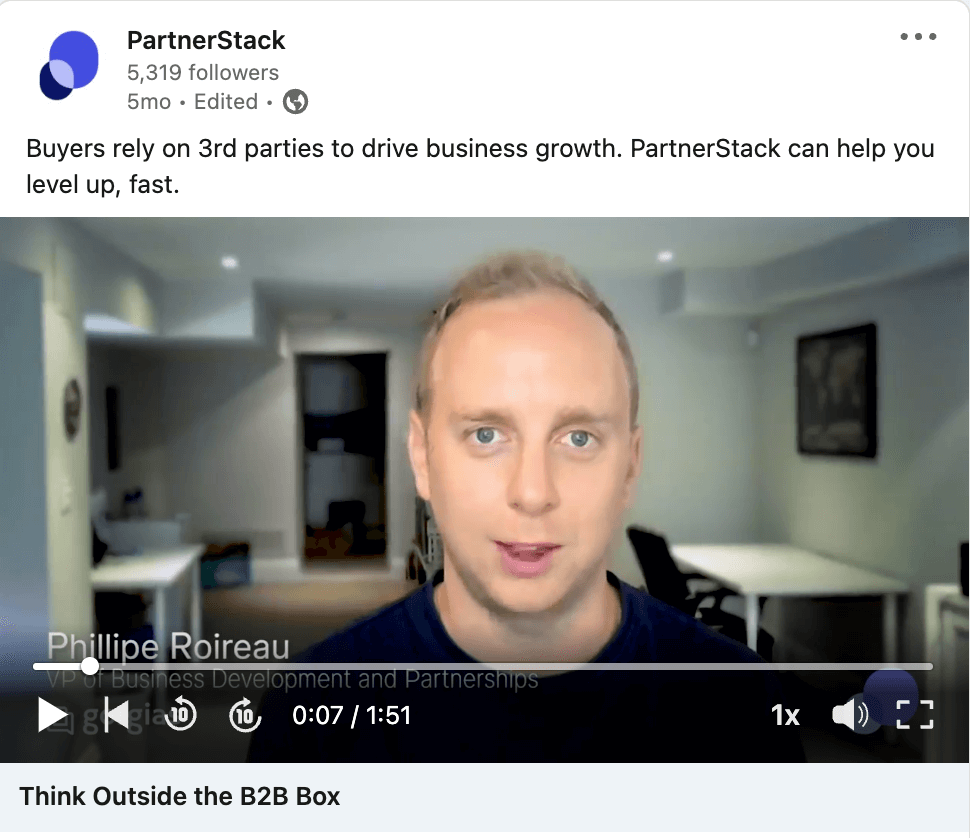
February 2022 – Customers Webpage – PartnerStack refreshes its brand and website, adding a customer page with the “sizzle reel” with Gorgias and other customer video testimonials as the hero image.

March 2022 – LinkedIn Sponsored Update video ad: Refreshed the October 2021 ad featuring Philippe (PartnerStack video ad, leveraging a 30-second excerpt from his video testimonial)
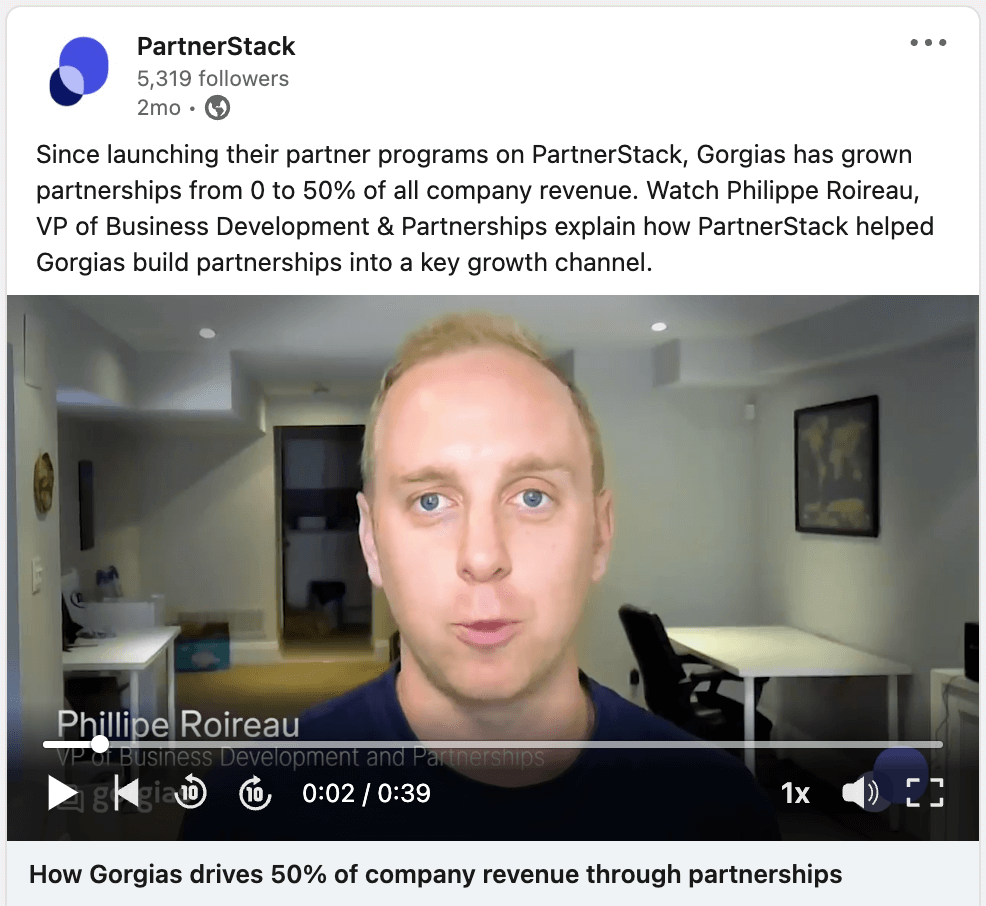
May 2022 – LinkedIn Sponsored Update image ad: Refreshed the November 2021 ad featuring Philippe (PartnerStack image ad, quoting from his video testimonial)
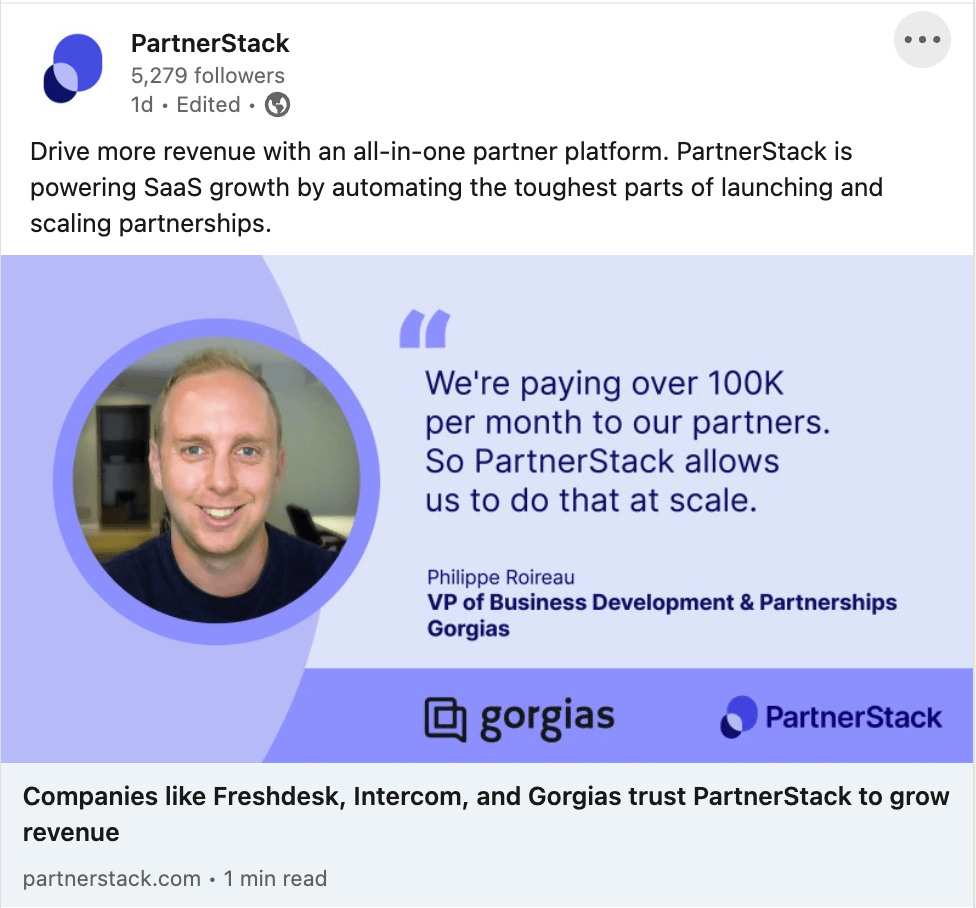
During this time, Gorgias was also telling others about its customer success story. In March 2021, Gorgias CEO Romain Lapeyre and Head of Operations Axelle Heems joined SaaStr Build to present “How Leveraging Partnerships Can 2x Your Growth”, viewed over 50,000 times at the time of writing.

Results of the PartnerStack promotion of Gorgias’s partner program success story
We’ve run Philippe’s video testimonial as a sponsored update on LinkedIn to several of our target audiences:- SMB cold prospects (7,100 person audience),
- MM cold prospects (18,000 person audience), and
- Retargeting audience (the right people from the right accounts who visit one of our landing pages, pricing page, book-a-demo page, 5-minute video demo video page, or product tour page).
- 92,158 impressions
- 80,491 views
- 14,579 video completions
- 65% reach (to our target audiences)
- $2,145 ad spend; less than 3 cents per view or 15 cents per video completion from a member of our target audience.
- 22,483 unique visitors (almost 2x the next most viewed video)
- 62.8% engagement rate (in line with our other testimonial videos and roughly 4x higher than our demo video)
In Conclusion
Testimonials, case studies and reviews create powerful social proof that persuades B2B buyers.
By leveraging these different forms of social proof, you increase your chances that your buyer will engage with your message based on where they are in their buying journey, what information they seek, and how they want to consume it.
Naturally, testimonials work best with product messaging, reviews on third-party websites, and other forms and sources of information used by today’s B2B SaaS buyers. Therefore, consider how social proof fits into the broader context of your go-to-market strategy.
Author
-
I'm the Founder and Editor-In-Chief of B2B SaaS Reviews. I'm also the Director of Demand Generation at PartnerStack, the #1 platform purpose-built for partner management and affiliate marketing in B2B SaaS. Before PartnerStack, I worked for other go-to-market B2B SaaS companies: Influitive (Advocate Marketing designed to generate more reviews, references, and referrals), LevelJump (Sales Enablement) (acquired by Salesforce) and Eloqua (Marketing Automation) (acquired by Oracle).


